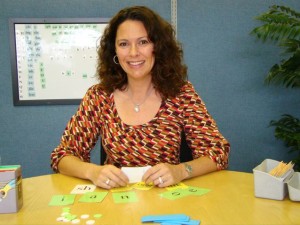
by PRIDE Reading Program Admin | Mar 26, 2014 | A PRIDE Post, IEP
Walking into an IEP is nerve-wracking. You’re thinking about what goals your child needs, the services that are essential, and the staff that will be most resistant to working with you. In fact, many parents are highly focused on the services that will be provided and lose sight of the purpose of the annual goals. Too often, parents readily breeze through goals in order to get to the meat of the IEP – placement and services. Similarly, parents often know why they want services, and they know their child’s unique needs, but they aren’t as versed in how the law obligates the District to provide the services. Using the right language can avoid common pitfalls that allow a District to reduce or eliminate services.
Annual Goals
The most important thing to remember about the goals is that they are annual goals. Making sure you have goals in all areas of need and that they are measurable is important, too. But none of that matters if the District sets the bar so low that any student could achieve the goal.
When thinking about goals, it’s important to consider where you want your child to be a year from now. Often, a school district will propose a goal that merely works on the next logical step, rather than where the child should be in a year. For example, I had one case where a young child had mastered single digit addition. The school district’s proposal? Addition of two digit numbers. While that is a worthy objective, it should not be an annual goal. If a child who can already do single digit addition spends all year and only learns that same skill with two numbers, rather than learning to subtract or multiply, it can hardly be said that he has made meaningful progress.
One tactic to think about is what other kids will be learning in his or her grade level. If your child is in second grade now, he or she will be a third grader at the next annual. So what does a typical third grader learn? Even if your child is a grade level behind, you want them to make meaningful progress. So if they are at the first grade level now, you want to at least shoot for a second grade level goal. Tying annual goals to grade levels is a good way to ensure that progress will be made.
Legal Lingo
When it comes to services, you should be aware of what the law requires – and what it doesn’t. Legally, the District must provide sufficient services for your child to get “some educational benefit” or “some meaningful benefit” from the education. In other words, it has to be enough for your child to make progress on goals. Some courts have compared it to a high school student progressing with about a C average.
Federal law, and the courts agree, does not require “best” services or services that would “maximize a child’s potential.” If you go in asking for the “best,” the District might even agree that what you are asking for is best, but will be well within its right to cut those services down. Instead, ask for what you want, but call them “appropriate” services. Anything less is “inappropriate.” While those words won’t magically sway the District, they will keep you from falling into the common parental pitfall of asking for the “best” – and then being promptly denied.
_________________________________________________________________________________________________

Drew Massey, Esq. graduated magna cum laude from Pepperdine Law School in 2006. Since that time, he has represented children and families with special needs in obtaining the necessary services so children can learn. You can reach him at (714) 698-0239 or email him at: DMassey@edattorneys.com or visit the Adams & Associates, APLC website at: https://californiaspecialedlaw.com

by PRIDE Reading Program Admin | Mar 20, 2014 | Autism
On April 2, 2014, Autism Speaks, the world’s leading autism advocacy organization, promotes their annual event called Light it Up Blue. This is a global initiative that kicks-off Autism Awareness Month. In honor of this day, many iconic landmarks, hotels, sporting venues, concert halls, museums and retail stores are among the many communities that take part in Light it Up Blue. Autism Speaks is dedicated to funding research into the causes, prevention, treatments and a cure for autism.
PRIDE Learning Center, will help raise awareness by participating in the Light it Up Blue campaign. All four Learning Centers will be decorated in blue with displays and handouts about autism on Wednesday, April 2, 2014 and there will be blue treats for the entire community. In addition, the employees at PRIDE Learning Center will be dressed in blue.
“We support the Light it Up Blue campaign,” says Karina Richland, owner of PRIDE Learning Centers. “We want to help increase the awareness of Autism Spectrum Disorders in the Orange County and Los Angeles communities and advocate for the needs of individuals with autism and their families” says Richland.
New autism statistics from the U.S Center for Disease Control and Prevention (CDC) identify around 1 in 68 American children as on the autism spectrum. Studies also show that autism is four to five times more common among boys than girls. An estimated 1 out of 42 boys and 1 in 189 girls are diagnosed with autism in the United States.
“We are so pleased and excited to participate in this event to bring autism awareness to the forefront and show that we at PRIDE Learning Center support research efforts to bring an end to this epidemic,” says PRIDE Learning Center owner, Karina Richland.
PRIDE Learning Center has four locations, San Clemente, Mission Viejo, Newport Beach and Redondo Beach, Ca. For more information contact PRIDE Learning Centers at 866-774-3342 or visit the website https://www.pridelearningcenter.com

by PRIDE Reading Program Admin | Mar 18, 2014 | A PRIDE Post, Reading Disability
Intervene early! Reading disabilities are considered to be the most common learning disability and are often not diagnosed or treated until it is too late for easy recovery. A child with a reading disability that is not identified until the third grade or later is already years behind his or her classmates. This is a gap that must be closed if the child is ever to catch up with his or her peers. The best intervention is in kindergarten or remediation beginning in the first grade.
Teach phonics. Through phonics, children learn to associate sounds and form connections to word recognition and decoding skills needed for reading. Research clearly proves that phoneme awareness performance is a major predictor of long- term reading and spelling success. In fact, according to the International Reading Association, phonemic awareness skills in kindergarten and first grade appear to be the most important predictor of successful reading acquisition.
Teach spelling. Spelling and reading rely on the same mental representations of a word. The correlation between spelling and reading comprehension is high because both depend on proficiency with language. The more profoundly and methodically a student knows a word, the more likely he or she is to recognize it, read it, spell it, write it, and use it appropriately in speech and writing.
Teach writing. Start teaching writing in preschool and kindergarten. Learning to write engages the brain in repetition and memory on how letters and sounds reflect meaning, addresses numerous reading and cognitive skills, and helps activate both reading and spelling areas of the brain.
Teach handwriting. Technology is a fun writing tool for kids but it doesn’t engage the early reading brain in the same helpful way as learning to move the pencil across the page to use letters as images of sound. Brain scan studies show that early lessons in letter formation help activate and coordinate reading connections in the brain.
Repetition, repetition, repetition. The brain of a child feeds on repetition to make doing things such as reading automatic and fluent. Use repetition in the early grades for reading aloud, for rhyming, for matching letters with sounds, for writing alphabet letters, for spelling, for sounding out words, for automatic reading of sight words, for making meaning in print. Children thrive on it. So make it fun!
Don’t ever give up on your child. Keep the expectations of your child and their reading future high. We owe it to our children to show our support, give them every resource possible to help them and give them the skills necessary for learning and communicating throughout their education and their lives.
________________________________________________________________________________________________________

Karina Richland, M.A. is the Founder and Director of PRIDE Learning Centers, located in Los Angeles and Orange County. Ms. Richland is a certified reading and learning disability specialist. Ms. Richland speaks frequently to parents, teachers, and professionals on learning differences, and writes for several journals and publications. You can visit the PRIDE Learning Center website at: www.pridelearningcenter.com

by PRIDE Reading Program Admin | Feb 18, 2014 | A PRIDE Post, Dyslexia
Because dyslexia is primarily associated with difficulty in learning to read, it cannot be reliably diagnosed until your child is the age at which reading typically begins. For most children this happens around the age of six. The following are some common characteristics that may be signs of dyslexia in preschool-age children:
- Jumbling sounds of words in speech, such as saying “pasgetti” for spaghetti” or “mawn lower” for lawn mover.”
- Confusing words signifying direction in space or time, such as “up” and “down,” “in” and “out,” “yesterday” and “tomorrow.”
- Forgetting or confusing the word for known objects, such as “table” or “chair.”
- Delayed speech development.
- Unusual speech patterns, such as frequent hesitations or stammering.
- Difficulty with learning.
- Difficulty remembering and following directions.
- Difficulty learning nursery rhymes and rhyming words.
- Difficulty in learning (and remembering) names of letters.
- Enjoys being read to but shows no interest in letters or words.
- Difficulty with clapping a simple rhythm.
In most cases you will probably not be aware that your child has dyslexia until he is in first or second grade. When reading instruction begins in earnest, your child is likely to lag behind and will begin to show signs of frustration at school. After several months, you may realize that your child simply hasn’t caught on to reading in the same way as his peers. He may still have difficulty recognizing letters of the alphabet, or he may know the letters and their sounds but seem unable to put them together to form even simple words. You may notice that he seems unable to remember words that he has seen before and struggles to sound out every word he sees.
The surest sign of dyslexia is simply the fact that your child seems bright and capable at home and at play, yet he struggles with reading, writing, and spelling. School-aged children with dyslexia will exhibit many of the following symptoms:
- Confusing letters with similar appearances, such as “b” and “d” or “e” and “c.”
- Writing that contains frequent reversals, transpositions, or inversions.
- Difficult remembering common sight words, even after repeated practice.
- Stumbling, hesitating, or making mistakes or omissions when reading small, easy words like “and” or “from.”
- Spelling phonetically and inconsistently such as writing “foniks” for “phonics” or “skul” for “school.”
- Complaining of dizziness, headaches, or stomachaches while reading.
Your first indication that something is wrong may be complaints from your child’s teacher about his behavior and problems he is experiencing at school. Many behavior problems stem from the dyslexia itself; your child’s teacher may complain that he doesn’t pay attention or follow directions, or that he is slow to complete class work. These issues may be the direct result of your child’s confusion and inability to understand much of what is going on around him. Other behavior problems may be deliberate and could be an expression of his frustration and anger; he may intentionally try to disrupt the class to create distractions so as to avoid having to complete his work. He would rather be known as the class clown than the class “dummy.” He may even want to incur punishment, if punishment means being sent to sit in the hallway or principal’s office. To a child with dyslexia, such punishment can be a welcome reprieve from the torture of the classroom. Some common behavior problems that your child’s teacher may report are:
- Laziness, carelessness, or immaturity
- Daydreaming
- Disruptive behavior
- Being easily distracted
- Resistance to following directions
- Reluctance to work on assignments
If you suspect that your child has dyslexia, you will want to seek testing and a diagnosis. Diagnostic testing will help you better understand your child and may guide you to make better choices. Ideally, testing should give you a map of your child’s strong and weak points, and a set of recommendations as to how best to meet his educational needs.
_________________________________________________________________________________________________________
Karina Richland, M.A. is the Founder of PRIDE Learning Centers, located in Los Angeles and Orange County. Ms. Richland is a Certified reading and learning disability specialist. Ms. Richland speaks frequently to parents, teachers, and professionals on learning differences, and writes for several journals and publications. You can visit the PRIDE Learning Center website at: www.pridelearningcenter.com

by PRIDE Reading Program Admin | Jan 7, 2014 | Pride Redondo Beach
Kami Weinstein, M.Ed., has been selected as the new Director for the PRIDE Learning Center in Redondo Beach.
In her role, Mrs. Weinstein will direct the daily operations of the tutoring center to provide quality instruction and evaluation as well as interact with staff, children and parents and promote the goals and objectives of the programs.
PRIDE Learning Center offers one-on-one tutoring and reading therapy sessions for students with learning disabilities including dyslexia, auditory and visual processing, ADHD, autism and other learning differences. PRIDE Learning Center offers reading, writing, comprehension and math tutoring programs for students of all ages.
“What a privilege it is to help lead the Redondo Beach team here at PRIDE Learning Center” states Weinstein. “ I look forward to an exciting new year in the South Bay community. I am confident that our multi-sensory based teaching methods will help many students soar to new heights in their reading and writing. What an honor it is to be a part of their development and growth in literacy.”
Weinstein earned her M.Ed in Reading and Literacy from Sam Houston State University in Texas with a TEFL teaching certification. She is certified in the Barton Reading and Spelling System, an Orton-Gillingham based reading program. She recently returned from Nairobi, Kenya where she used her Orton-Gillingham expertise with learners struggling with dyslexia and learning disabilities.
“I saw great reading success with my students in Kenya using the Orton-Gillingham reading and spelling program just as I have seen huge progress with those using our programs here at PRIDE.” says Weinstein. “ A learner’s confidence and future really is changed when they can learn to read and write; I love being a part of that change.”
There will be an Open House for the public to come meet PRIDE Learning Center’s new Director, Kami Weinstein on Thursday, January 23rd from 1:00pm – 3:00pm. PRIDE Learning Center is located at 1603 Aviation Blvd., Suite G, Redondo Beach, CA 90278. For more information contact Kami Weinstein at 310-322-2800 ext. 6 or you can visit the PRIDE Learning Center website at: www.pridelearningcenter.com







